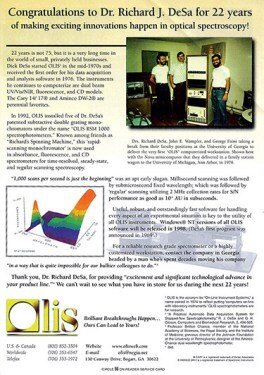Not known Details About Circular Dichroism
Not known Details About Circular Dichroism
Blog Article
The Greatest Guide To Spectrophotometers
Table of ContentsSome Known Facts About Circular Dichroism.Spectrophotometers Things To Know Before You Get ThisThe Buzz on Uv/vis/nirSome Known Factual Statements About Circular Dichroism The Ultimate Guide To Circularly Polarized Luminescence

Spectrophotometry is a tool that hinges on the quantitative analysis of particles depending on how much light is absorbed by colored substances.
7 Easy Facts About Spectrophotometers Shown
A spectrophotometer is commonly used for the measurement of transmittance or reflectance of solutions, transparent or opaque solids, such as polished glass, or gases. Although many biochemicals are colored, as in, they soak up visible light and therefore can be measured by colorimetric procedures, even colorless biochemicals can often be transformed to colored substances appropriate for chromogenic color-forming reactions to yield substances appropriate for colorimetric analysis.: 65 Nevertheless, they can also be created to determine the diffusivity on any of the noted light varieties that generally cover around 2002500 nm using different controls and calibrations.
An example of an experiment in which spectrophotometry is utilized is the determination of the balance constant of an option. A specific chemical reaction within a solution may take place in a forward and reverse direction, where reactants form items and items break down into reactants. At some time, this chemical reaction will reach a point of balance called an equilibrium point.
The Buzz on Uv/vis
The quantity of light that passes through the option is a sign of the concentration of certain chemicals that do not enable light to go through. The absorption of light is because of the interaction of light with the electronic and vibrational modes of molecules. Each kind of molecule has a specific set of energy levels associated with the makeup of its chemical bonds and nuclei and therefore will absorb light of specific wavelengths, or energies, leading to unique spectral residential or commercial properties.
They are extensively used in lots of markets including semiconductors, laser and optical manufacturing, printing and forensic examination, as well as in labs for the research study of chemical compounds. Spectrophotometry is often used in measurements of enzyme activities, determinations of protein concentrations, determinations of enzymatic kinetic constants, and measurements of ligand binding reactions.: 65 Eventually, a spectrophotometer is able to identify, depending on the control or calibration, what substances are present in a target and exactly how much through estimations of observed wavelengths.
Invented by Arnold O. Beckman in 1940 [], the spectrophotometer was created with the aid of his coworkers at his company National Technical Laboratories established in 1935 which would become Beckman Instrument Business and ultimately Beckman Coulter. This would come as a service to the previously produced spectrophotometers which were see post unable to take in the ultraviolet properly.
10 Simple Techniques For Uv/vis
It would be discovered that this did not give satisfactory results, therefore in Model B, there was a shift from a glass to a quartz prism which enabled much better absorbance results - UV/Vis/NIR (http://www.video-bookmark.com/bookmark/6114703/olis-clarity/). From there, Model C was born with an adjustment to the wavelength resolution which ended up having 3 units of it produced
It irradiates the sample with polychromatic light which the sample soaks up depending upon its homes. Then it is transmitted back by grating the photodiode array which finds the wavelength area of the spectrum. Since then, the creation and application of spectrophotometry gadgets has increased tremendously and has turned into one of the most innovative instruments of our time.

Everything about Uv/vis
Historically, spectrophotometers use a monochromator consisting of a diffraction grating to produce the analytical spectrum. The grating can either be movable or repaired. If a single detector, such as a photomultiplier tube or photodiode is utilized, the grating can be scanned stepwise (scanning spectrophotometer) so that the detector can determine the light intensity at each wavelength (which will represent each "action").
In such systems, the grating is fixed and the strength of each wavelength of light is measured by a various detector in the array. Additionally, most modern mid-infrared spectrophotometers use a Fourier change method to acquire the spectral details - https://hubpages.com/@olisclarity1. This method is called Fourier transform infrared spectroscopy. When making transmission measurements, the spectrophotometer quantitatively compares the fraction of light that goes through a referral solution and a test service, then digitally compares the strengths of the two signals and computes the percentage of transmission of the sample compared to the referral requirement.

Report this page